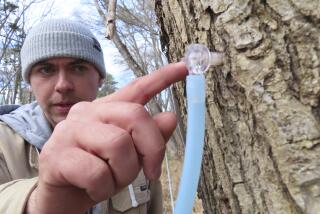AGRICULTURE : Farmers’ Pride Grows as Cranberries Thrive : 45% of world’s crop comes from Massachusetts, where the fruit is a $100-million industry.
- Share via
CARVER, Mass. — Jack Angley said he takes pride that the cranberries he grows on 30 marshy acres outside his home end up across the country as sauce on a Thanksgiving table or strung from a Christmas tree.
“It’s nice, the thought of it coming from my bog in Massachusetts. Once in a while, you think of that,” said Angley, 52, his face windburned and his hands worn from a month of harvesting 360,000 pounds of bright red cranberries.
While farmers in agriculturally rich states may find it common to see their crops consumed elsewhere, it is a particular source of satisfaction here to cranberry growers in a state that imports 85% of its food.
The 450 cranberry growers, who farm 12,700 acres of bog, or marshland, in southeastern Massachusetts, comprise the only farming industry in which the state plays a leading role nationally. About 45% of the world’s cranberries are grown in Massachusetts, and about half the 900 farmers are here.
The $100-million annual income generated by cranberry growers far outpaces that of the state’s other food crop growers.
Massachusetts’ once-thriving farming industry was all but devastated in the three decades after World War II, when about 200 farm businesses annually were being lost to development. State programs have since helped halt the decline. But many of the remaining farmers, particularly dairy, have been beset by economic woes.
On top of its own problems, the farming industry, in general, has shared in a New England recession that, according to a recent study by Northeastern University, has wiped out gains made during the 1980s in reducing poverty.
Against that backdrop, the relative success of the cranberry industry has delighted growers and state officials alike.
According to the Cape Cod Cranberry Growers’ Assn., Massachusetts produced nearly 1.9 million barrels of cranberries this year.
Spirits are especially high among growers because this year’s harvest was a robust one, something sorely needed after a poor crop last year.
One of only three native American fruits, cranberries grow on low-lying vines in marshy areas. While there is debate about whether they were actually consumed at the first Thanksgiving, they are known to have been eaten by Indians fresh off the vine or mixed with meat, and used to make poultice and dyes.
Settlers also ate them, and in 1817 a Cape Cod whaler, Henry Hall, began the first commercial cultivation of the crop after discovering that some of his wild cranberry vines produced richer berries when covered with ocean-blown sand. Hall began covering his bogs with sand, a technique used today to stimulate crop yield.
His discovery led to an era of bog construction in Cape Cod and other parts of southeastern Massachusetts. Many of today’s bogs--and the perennial cranberry plants--date from the turn of the century.
Growers say the industry’s success here is partly because of the natural features of the area, including its moderately cold winters and sandy, acidic soil that favor cranberries.
But equally important, according to many growers, was the formation in 1930 of Ocean Spray, a farmers’ cooperative, to market the product. About 75% of Massachusetts’ cranberry farmers, and 85% of those nationwide, belong to Ocean Spray.
Growers say Ocean Spray transformed cranberries from a sauce ingredient at holiday meals to a year-round product by developing since 1960 the host of blended juices that made the tart berry palatable to consumers. Today the company, still a farmers’ cooperative, has annual sales of nearly $1 billion.
Farmers, meanwhile, have grown more sophisticated with their production. Today, the most common technique for harvesting, which occurs in late September and October, involves flooding the bogs and shaking ripe berries from the vines with “water reel” machines. The berries are then corralled and loaded onto trucks. A less common method employs machines that comb berries from dry vines.
Cranberry growers say they take pride not only in the 5,400 jobs their industry creates in Massachusetts, but also in the 62,000 acres of open space they are preserving.
More to Read
Inside the business of entertainment
The Wide Shot brings you news, analysis and insights on everything from streaming wars to production — and what it all means for the future.
You may occasionally receive promotional content from the Los Angeles Times.










